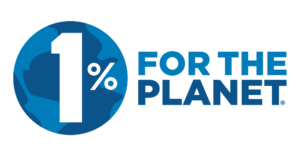Sponsors are invoiced (with VAT) for their contribution and can therefore benefit from a personalised webpage on our website.
Donors make a charitable gift that can be tax-deductible. Donor logos can be featured on our website, but donors don’t receive a personalised webpage.
If you fund forest restoration and are not measuring and reducing your own carbon, water and waste footprint, then yes – you could be accused of greenwashing.
We focus on restoration costs per hectare, so the price per tree is calculated by dividing this cost by the target density of trees we want to achieve. For example, €4 000 per hectare and a target density of 2 000 trees would equal a tree price of €2. On average the cost of a tree varies between €0.50 and €3, depending on the restoration technique and the location (see the question Why does the price per tree differ between projects?).
The cost is influenced by the different restoration techniques (e.g. framework planting versus assisted natural regeneration), the accompanying programmes such as developing forest-friendly livelihoods (e.g. beekeeping), as well as the local conditions and economy in the country.
Our income includes funding from sponsorships and donations as well as income from sales of carbon credits. For every euro of our income since 2017, 60% has been spent in the field: growing the seedlings, planting the trees, training local communities for long-term forest protection and developing local alternatives to forests and trees as the communities’ main income. 18% for WeForest overheads pays salaries for headquarters-based staff that support funders and grow the cause, as well as the pipeline for new projects. 6% for specialist support has included expertise in livelihood programme design. 4% has funded scientific research such as the installation of flux towers that provide insights into the interaction of new forests with the water cycle. The remaining 12% has established reserves like the Tree Guarantee Fund that can establish a ‘buffer’ in case of fire or drought, or release funds for repairing sites that have suffered such events.
Our finances are audited every year. External auditors perform reconciliations between the number of hectares invoiced and the number of hectares allocated to our sponsors, and they also perform integrity tests of the database where the information is recorded. The external audit of financial records means that monies are accounted for from the moment these enter WeForest’s account to the restoration activities on the ground, including the project’s non-planting activities, such as capacity building and socio-economic activities, which are essential for long-term tree survival and success. This stringent process means no polygon (restoration area) could be assigned twice to a funder.
As an organisation working for impact for people, nature and climate, we have strategic goals around carbon sequestration and avoided emissions. Several of our projects have been certified under standards including REDD+ and VERRA, but we do not aim to be a carbon offsetting solution.
If you want to work with WeForest to demonstrate your business’s contribution to climate solutions, you can:
Option 1: Give direct support to WeForest, because we know and are transparent about how much carbon our projects are sequestering, and, in the case of our REDD+ projects, how many emissions have been avoided through preventing deforestation. By supporting our forest and landscape restoration (FLR), you are creating amazing impacts for climate, people and nature. The trees will absorb CO2 as they grow and mature. We will guide you through the claims you can make using our wealth of monitoring data.
Option 2: Purchase carbon credits, but we do not recommend that you use them for offsetting purposes. We source high-quality carbon credits from third party projects certified under standards including VERRA, REDD+, Gold Standard and Plan Vivo, and they are always ones for which the carbon has already been stored.
Contact us for more information.
As a partner you have immediate access to pictures, videos and content for your own communications. New material is sent regularly throughout the year while you remain an active partner. See some examples of our pictures here. We also send biannual reports giving you project updates and stories from the field.
As a partner you have immediate access to pictures, videos and content for your own communications. New material is sent regularly throughout the year while you remain an active partner. See some examples of our pictures here. We also send biannual reports giving you project updates and stories from the field.
Established in 2010, WeForest develops holistic and multi-stakeholder reforestation projects through a Forest and Landscape Restoration approach, mostly in tropical regions. Our vision is of a world where communities and nature sustainably thrive together to stop global warming ‘in our lifetime’. Our mission is focused on conserving and restoring the ecological integrity of forest landscapes with local communities to deliver lasting solutions for climate, nature and people. Today (2022) we have over 49 000 hectares (490 million m2) and 61 million trees under restoration across 3 continents, and aim by 2025 to reach a total of 100 000 hectares (100 million trees).
Social entrepreneur Bill Liao and Marie-Noelle Keijzer founded WeForest with a very clear ambition: to stop global warming “in our lifetime so our children don’t have to”. For the first three years everyone was a volunteer. Today, WeForest is a team of more than 90 passionate professionals across the world.
We grow trees in areas that have the most impact on people, nature and the planet. We focus our efforts in the tropics for several reasons:
We usually plant during the rainy season, when the soil provides the best conditions for survival. The time between your sponsorship or donation and the actual tree planting varies depending on the region you support and the time of year. Important project activities – such as growing seedlings in the tree nurseries or providing training – happen all year round.
The age of the seedlings depends on the ecosystem, and project location. In Ethiopia, for example, most seedlings are planted after being taken care of for nine months in a tree nursery. In Brazil, transplanting can already happen after four months.
We can send you payment confirmation on WeForest letterhead to confirm receipt of your payment and where these funds will be going. We can also create an annual impact certificate to highlight how much you have funded and what impact this has had on our projects, such as hectares of land restored or number of trees growing.
We use mixed methods – planting trees, agroforestry, assisted natural regeneration and protection – to ensure that forests thrive.
Planting a tree is easy; anyone can do it. But planting the wrong tree in the wrong place can actually do more harm than good. What matters is growing healthy forests that thrive in the long term. We work on a landscape level, and our forest restoration strategy considers both ecological and socio-economic needs. Our projects therefore carefully select the tree species that have the greatest value for the environment, as well as the lives of the people living in and around the forests.
Assisted Natural Regeneration (ANR) is a restoration approach that enhances the establishment of forests by protecting and nurturing emerging wild seedlings that are already present, resulting in greater success compared to transplanting nursery-grown seedlings. It includes patrolling, avoiding overgrazing and implementing preventive fire management to reach the optimal density of trees per hectare for the location. Watch a video about it here.
ANR can be complemented with enrichment planting – enhancing the density of desired tree species – and transplanting saplings where needed. We often combine ANR and enrichment planting with agroforestry, in which farmers plant various fruit and timber species at their homes to increase family income.
With nature, there is never a 100% guarantee that the trees will survive. We look at the risks and develop a risk mitigation plan for each project. WeForest’s purpose is not just growing trees: what matters is their long-term survival. Our projects empower communities to become stewards of their forest through training and forest-friendly livelihoods. The livelihood activities that we fund reward local farmers and herders for keeping their livestock out of the forest, for example.
Find more information under What We Do.
Local communities still rely heavily on forests to provide wood for construction and for fuelwood. In some of our projects, we work with communities to plant fast growing species and woodlots where trees can be harvested to meet their needs. This relieves pressure on the areas of degraded forest we are working to restore.
WeForest is grounded in science, and monitoring is an essential aspect of our work. We establish permanent monitoring plots and visit them annually (in most cases) to gather data on key characteristics such as the rate of survival of planted trees, the abundance of species, and the rate of natural regeneration and tree growth over time, among other indicators. Where social impacts are also critical, we measure socio-economic indicators such as the number of beneficiaries and the number of people expanding their capacity to generate income from forest-friendly livelihood activities. This allows us to track our progress, adapt our management strategy and respond to changing conditions.
Fires are a real threat to forests and our projects include the development and maintenance of firebreaks as a mitigation strategy. In case of a natural disaster, we do have a tree guarantee fund which enables us to replant if needed.
Restoration projects are long term. We usually foresee a minimum of eight years and our objective is to make projects self-sustaining so that they can continue long after we leave.
What matters is the long-term survival of the trees, so we engage and train local farmers who earn a stable income from the project and make them stewards of their new forest.
Women are still responsible for household work in many countries. In places where forests are degraded, they often spend many hours every day collecting fuelwood, water and other forest products such as mushrooms and nuts. This makes them the primary users of forest resources. Nevertheless, women are often excluded from forest management, decision making and access to resources, as in many countries, forestry is perceived as being ‘men’s business’.
Successful forest restoration requires women to be involved in the design and development of activities. We ensure that we organise meetings at times that are suitable to their busy schedules, directly engage with them in meetings, and organise separate meetings if needed so that they feel comfortable to express themselves.
Improving forest management for better growth and health of trees means pruning, which can deliver reliable supplies of firewood closer to home, and results in more resources such as mushrooms that can be collected and sold.
By increasing forest-friendly incomes, we can reduce the pressure on forests. Income-generating activities such as beekeeping are primarily male-dominated, and female-headed households in our programmes have a preference for egg production and sheep rearing that can generate a more regular or substantial income. We also promote more sustainable food production practices such as agroforestry and conservation agriculture, which increase yields. Vegetable gardening for subsistence – and feeding families – is often the responsibility of women, and directly impacts health, nutrition and income.
In some of our project locations, beehives have amazing potential to prevent deforestation. The revenue received through selling honey can provide a significant income for the farmer and his or her family, sometimes doubling it. Since bees need healthy flowering trees to flourish, they provide a great incentive to keep the trees standing and the extra income avoids the need to generate income from illegal logging and charcoal burning. We promote the message ‘no bees – no trees, no honey – no money’.
Different tree species grow and sequester CO2 at different rates. However, focusing only on fast-growing species alone is not the best approach. No natural forest is made up of just one species, and our goal is to restore them as much as possible to a ‘natural’ state. A forest is not just for storing carbon: biodiversity and people and animals that depend on forests need a diversity of species.
A recent study found that, considering the current Bonn Challenge pledges for restoration, the best strategy by far to store the most carbon by 2100 would be to focus on natural forest restoration and protection – because on average, natural forests are six times better than agroforestry and 40 times better than plantations at storing carbon.
We estimate carbon sequestration across a hectare of forest with all its species diversity.
The latest FAO assessment of global forest resources estimates that, since 2015, ten million hectares a year of forest cover was lost and five million hectares of forest cover was gained. Over the period 1990 to 2020 the rate of global forest loss has declined, but still far outweighs forest gain.
There are several things you can do:
If your company is carbon neutral, you’re balancing out your carbon emissions into the atmosphere by removing them elsewhere, usually by purchasing carbon offsets or credits to make up the difference. Carbon neutral doesn’t necessarily mean you have reduced your emissions (which should be the first priority).
A climate neutral company or product is neutral in all greenhouse gas emissions, not just carbon carbon dioxide: also methane (CH4), nitrous oxide (N2O), hydrofluorocarbons (HFCs), perfluorocarbons (PFCs), sulphur hexafluoride (SF6) and nitrogen trifluoride (NF3). As with carbon neutral, this name doesn’t necessarily mean you have reduced your emissions (which should be the first priority).
Net Zero means not putting any more carbon into the atmosphere than you’re taking out. Net Zero companies find ways to reduce their own emissions first; they also have a wider scope of the emissions they count in all steps on the supply chain. This includes the most difficult ‘scope 3’, like the emissions from growing the cocoa that ends up in your chocolate, and even employee commutes – and sometimes even the ongoing emissions of the products they sell. You can’t offset your way out of Net Zero.
Trees compensate for greenhouse gas emissions over time by drawing down carbon dioxide as they grow. The best carbon is carbon that is never emitted, so we encourage every company to reduce and avoid emissions before choosing to compensate. If you do need to claim immediate carbon neutrality, though, we offer carbon credits from certified forest restoration or conservation projects where the trees are already growing, so the CO2 has already been saved.
Find out more about Net Zero pledges here.
See which solution is right for you and get started today.
HQ (BE): WeForest asbl/vzw
Cantersteen 47, 1000 Brussels, Belgium
VAT number BE0826.151.968
Incorporated May 26th 2010
WeForest is a supporting member of:





| Cookie | Duration | Description |
|---|---|---|
| __cf_bm | 1 hour | This cookie, set by Cloudflare, is used to support Cloudflare Bot Management. |
| _GRECAPTCHA | 6 months | Google Recaptcha service sets this cookie to identify bots to protect the website against malicious spam attacks. |
| cookielawinfo-checbox-analytics | 11 months | This cookie is set by GDPR Cookie Consent plugin. The cookie is used to store the user consent for the cookies in the category "Analytics". |
| cookielawinfo-checbox-functional | 11 months | The cookie is set by GDPR cookie consent to record the user consent for the cookies in the category "Functional". |
| cookielawinfo-checbox-others | 11 months | This cookie is set by GDPR Cookie Consent plugin. The cookie is used to store the user consent for the cookies in the category "Other. |
| cookielawinfo-checkbox-advertisement | 1 year | Set by the GDPR Cookie Consent plugin, this cookie records the user consent for the cookies in the "Advertisement" category. |
| cookielawinfo-checkbox-necessary | 11 months | This cookie is set by GDPR Cookie Consent plugin. The cookies is used to store the user consent for the cookies in the category "Necessary". |
| cookielawinfo-checkbox-performance | 11 months | This cookie is set by GDPR Cookie Consent plugin. The cookie is used to store the user consent for the cookies in the category "Performance". |
| CookieLawInfoConsent | 1 year | CookieYes sets this cookie to record the default button state of the corresponding category and the status of CCPA. It works only in coordination with the primary cookie. |
| elementor | never | The website's WordPress theme uses this cookie. It allows the website owner to implement or change the website's content in real-time. |
| JSESSIONID | session | New Relic uses this cookie to store a session identifier so that New Relic can monitor session counts for an application. |
| Path | session | Description is currently not available. |
| viewed_cookie_policy | 11 months | The cookie is set by the GDPR Cookie Consent plugin and is used to store whether or not user has consented to the use of cookies. It does not store any personal data. |
| Cookie | Duration | Description |
|---|---|---|
| _hjAbsoluteSessionInProgress | 1 hour | Hotjar sets this cookie to detect a user's first pageview session, which is a True/False flag set by the cookie. |
| _hjIncludedInSessionSample_2773626 | 1 hour | Description is currently not available. |
| aka_debug | session | Vimeo sets this cookie which is essential for the website to play video functionality. |
| authstrategy | session | Description is currently not available. |
| li_gc | 6 months | Linkedin set this cookie for storing visitor's consent regarding using cookies for non-essential purposes. |
| lidc | 1 day | LinkedIn sets the lidc cookie to facilitate data center selection. |
| pll_language | 1 year | Polylang sets this cookie to remember the language the user selects when returning to the website and get the language information when unavailable in another way. |
| UserMatchHistory | 1 month | LinkedIn sets this cookie for LinkedIn Ads ID syncing. |
| Cookie | Duration | Description |
|---|---|---|
| SRM_B | 1 year 24 days | Used by Microsoft Advertising as a unique ID for visitors. |
| Cookie | Duration | Description |
|---|---|---|
| _ga | 1 year 1 month 4 days | Google Analytics sets this cookie to calculate visitor, session and campaign data and track site usage for the site's analytics report. The cookie stores information anonymously and assigns a randomly generated number to recognise unique visitors. |
| _ga_* | 1 year 1 month 4 days | Google Analytics sets this cookie to store and count page views. |
| _gcl_au | 3 months | Google Tag Manager sets the cookie to experiment advertisement efficiency of websites using their services. |
| _hjFirstSeen | 1 hour | Hotjar sets this cookie to identify a new user’s first session. It stores the true/false value, indicating whether it was the first time Hotjar saw this user. |
| _hjSession_* | 1 hour | Hotjar sets this cookie to ensure data from subsequent visits to the same site is attributed to the same user ID, which persists in the Hotjar User ID, which is unique to that site. |
| _hjSessionUser_* | 1 year | Hotjar sets this cookie to ensure data from subsequent visits to the same site is attributed to the same user ID, which persists in the Hotjar User ID, which is unique to that site. |
| ajs_anonymous_id | 1 year | This cookie is set by Segment to count the number of people who visit a certain site by tracking if they have visited before. |
| ajs_group_id | 1 year | This cookie is set by Segment to track visitor usage and events within the website. |
| ajs_user_id | 1 year | This cookie is set by Segment to help track visitor usage, events, target marketing, and also measure application performance and stability. |
| AnalyticsSyncHistory | 1 month | Linkedin set this cookie to store information about the time a sync took place with the lms_analytics cookie. |
| CLID | 1 year | Microsoft Clarity set this cookie to store information about how visitors interact with the website. The cookie helps to provide an analysis report. The data collection includes the number of visitors, where they visit the website, and the pages visited. |
| CONSENT | 2 years | YouTube sets this cookie via embedded YouTube videos and registers anonymous statistical data. |
| MR | 7 days | This cookie, set by Bing, is used to collect user information for analytics purposes. |
| s_vi | 2 years | An Adobe Analytics cookie that uses a unique visitor ID time/date stamp to identify a unique vistor to the website. |
| SM | session | Microsoft Clarity cookie set this cookie for synchronizing the MUID across Microsoft domains. |
| VISITOR_PRIVACY_METADATA | 6 months | Description is currently not available. |
| vuid | 1 year 1 month 4 days | Vimeo installs this cookie to collect tracking information by setting a unique ID to embed videos on the website. |
| Cookie | Duration | Description |
|---|---|---|
| ANONCHK | 10 minutes | The ANONCHK cookie, set by Bing, is used to store a user's session ID and verify ads' clicks on the Bing search engine. The cookie helps in reporting and personalization as well. |
| bcookie | 1 year | LinkedIn sets this cookie from LinkedIn share buttons and ad tags to recognize browser IDs. |
| bscookie | 1 year | LinkedIn sets this cookie to store performed actions on the website. |
| IDE | 1 year 24 days 1 minute | Google DoubleClick IDE cookies store information about how the user uses the website to present them with relevant ads according to the user profile. |
| li_sugr | 3 months | LinkedIn sets this cookie to collect user behaviour data to optimise the website and make advertisements on the website more relevant. |
| muc_ads | 1 year 1 month 4 days | Twitter sets this cookie to collect user behaviour and interaction data to optimize the website. |
| MUID | 1 year 24 days | Bing sets this cookie to recognise unique web browsers visiting Microsoft sites. This cookie is used for advertising, site analytics, and other operations. |
| personalization_id | 1 year 1 month 4 days | Twitter sets this cookie to integrate and share features for social media and also store information about how the user uses the website, for tracking and targeting. |
| test_cookie | 15 minutes | doubleclick.net sets this cookie to determine if the user's browser supports cookies. |
| VISITOR_INFO1_LIVE | 6 months | YouTube sets this cookie to measure bandwidth, determining whether the user gets the new or old player interface. |
| YSC | session | Youtube sets this cookie to track the views of embedded videos on Youtube pages. |
| yt-remote-connected-devices | never | YouTube sets this cookie to store the user's video preferences using embedded YouTube videos. |
| yt-remote-device-id | never | YouTube sets this cookie to store the user's video preferences using embedded YouTube videos. |
| yt.innertube::nextId | never | YouTube sets this cookie to register a unique ID to store data on what videos from YouTube the user has seen. |
| yt.innertube::requests | never | YouTube sets this cookie to register a unique ID to store data on what videos from YouTube the user has seen. |
| Cookie | Duration | Description |
|---|---|---|
| __tld__ | session | Description is currently not available. |
| ajscookies | 1 year | No description available. |
| ajstest | 1 year | No description available. |
| debug | never | No description available. |